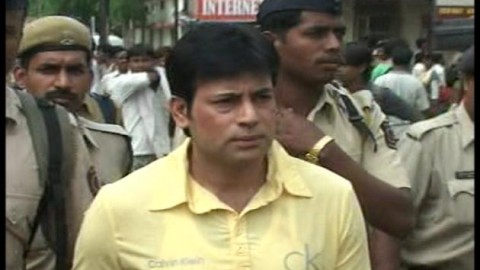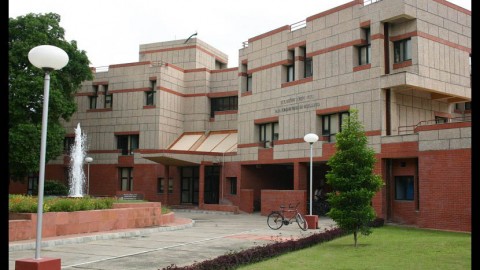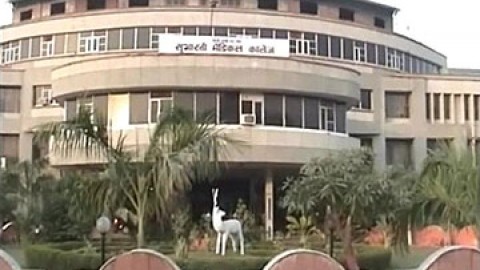First and foremost, introducing RAJAN’S FAMILY:
Wife-
Police claim Rajan’s wife Sujata Nikhalje, ran his entire operation and empire in the city of Mumbai, after he moved out of the country. She was arrested in December 2005 under the stringent MCOCA law for extorting money from builders involved in redevelopment projects in Tilak Nagar. She was released on bail in 2007. The couple have three daughters. The youngest and eldest daughter live in Tilak Nagar with her, while the second daughter is studying abroad.
Parents-
Father: Sadashiv Nikhalje was an employee at the Sion-based Swadeshi mills. When he lost his job in the late ’70s, it put a financial strain on the family.
Mother: Laxmibai Nikhalje was known to be a deeply religious person. Locals say she played a major role in setting up a Buddhist place of worship in Tilak Nagar. She died last February, at the age of 85.
Siblings-
 Prakash Nikhalje: A family friend claimed that the eldest of the six siblings was pushed into black marketing of cinema tickets after their father lost his job. Prakash was arrested with Rajan’s wife Sujata in 2005 after a builder alleged they had extorted Rs 10 lakh from him. He is believed to have later shifted to Pune and died in 2011 of a heart attack at the age of 54.
Prakash Nikhalje: A family friend claimed that the eldest of the six siblings was pushed into black marketing of cinema tickets after their father lost his job. Prakash was arrested with Rajan’s wife Sujata in 2005 after a builder alleged they had extorted Rs 10 lakh from him. He is believed to have later shifted to Pune and died in 2011 of a heart attack at the age of 54.
Akash Nikhalje: Known to lead a simple lifestyle, Akash does odd jobs and is hardly recognised by anyone as he moves around on his Hero Honda. A friend says he prefers the anonymity. “The family is happy. We hope he will be safe here. He is no terrorist,” is all he said of his brother.
Deepak Nikhalje: Deepak has fought successive polls on the Republican Party of India (Athawale) ticket and is a senior leader of the party. His recent claim to fame was sharing the dais with Prime Minister Narendra Modi during his Mumbai visit.
Sunita, Malini: Rajan’s sisters, who are known as “akka”, still live in Tilak Nagar and are known to be socially active.
—–
The year of 1968 at the Amchi Shala Marathi- medium school at Tilak Nagar in Mumbai’s central suburb of Chembur had at least one bully. And it wasn’t Rajendra Sadashiv Nikhalje.
A front bencher and a recluse, a crying Rajendra would approach the class teacher pointing to the ink sploshed on his shirt by a student sitting behind him. That summer, his classmates picked up the Class VIII-B squealer and locked him in a school bathroom. They still recall his loud calls as he banged on the door, shouting to be let free.
“Toh kaay kadka hota tya veli, kaay karu shakla asta (He was such a weakling then, what could he have done?),” states one of his classmates.
Twenty-nine years after he left the country, images of a restless Rajendra aka Chhota Rajan, being hurried along in an orange federal prison jumpsuit, continue to amuse his classmates. The television grabs, which are now playing on a loop, have finally replaced the popular imagination of the once sidekick, later rival, of another famous fugitive, Dawood Ibrahim.
But far away from the “joint intelligence operation” carried out by Indian, Indonesian and Australian forces, at least in a few homes in Mumbai’s Tilak Nagar, his old friends and neighbours see him as a once “timid” school boy who has travelled far and needs to be brought back home.
At Tilak Nagar, nestled between the two affluent, posh suburbs of Chembur and Ghatkopar, media cameras perched on tripods take live shots of a cinema house. At Sahakar Cinema’s Wednesday matinee show, a huge poster of the movie Shaandaar shows the mint pair of Shahid Kapoor and Alia Bhatt luring a new generation of lovers and loners. The big story, though, as always, is playing outside its ticket counters, of an old resident from the locality. Till over a decade ago, the 112 chawls of Tilak Nagar stood in a semi-circular formation around the Lokmanya Tilak ground. They have mostly given way to redeveloped buildings.
Rajendra’s Tilak Nagar of the 1970s was different from Chhota Rajan’s in the 1980s. Today, this is a new neighbourhood where young mothers take leisurely evening walks, their children tucked in prams, where men go to local gymnasiums and where there are at least four ATMs at every traffic junction.
Rajendra’s Tilak Nagar was different. The 112 chawls, which belonged to the Bombay of mill workers, stood three-storeys tall in a semi-circular formation around the Lokamanya Tilak ground. In the few remaining chawls and among those who moved into the redeveloped high-rises that have mostly replaced the chawls, there are fond memories of a time when long corridors were ground for gossip, floors didn’t divide but only “helped in stealing a neighbour’s dry pickles or share Diwali sweets”, and where no one slept without hearing a bedside story, even if it was of the struggling days of mill strikes.
Tilak Nagar was where you didn’t want to lose your way. Not because of any inherent danger, but because of the randomly numbered chawls. No. 58 could be adjacent to No. 86. And you could spend hours circling the shaded streets of the lower middle-class area, as if lost in a maze.
While there’s little left of that old Tilak Nagar, at least two of its iconic landmarks, the cinema house and the playground, still remain, as a reminder of the Rajan story. For, it is between the Sahakar Plaza and Lokmanya Tilak ground that Chhota Rajan was born.
Around 1976, the mill strife had just begun, with low wages creating issues for the industrial class. Like many others, Sadashiv shifted to doing odd jobs and the family, which shared a 150-square-foot living space, had their difficult moments.
And squabbles were not limited. A close friend of Rajendra recalls a family anecdote from that day. After he got his salary on the 10th of every month, Sadashiv would take his youngest son Deepak to Deepak Farsan Mart near Kurla railway station and buy sev bundi for the family. Since Deepak was always a favourite, he would get the first right to eat and consume a major chunk of the snacks. “Deepak told me about this episode very recently,” recalls a family friend.
By the late seventies, as trade union leader Dutta Samant became the face of the mill workers’ strife, many mill colonies, including Tilak Nagar, saw young boys drop out of school and take up odd jobs. Rajendra too dropped out when he was in Class XI. “He was an average student. I remember, during school hours, he would be interested in lezim, a Marathi folk dance performed using a small musical instrument with jingling cymbals,” recalls an old friend from Tilak Nagar.

Dawood-and-Rajan
When the financial burden got worse, it wasn’t unnatural for Rajendra to walk to the closest landmark, Sahakar Plaza Cinema, for a job. He eventually started selling tickets in black.
Rajendra’s new vocation brought him close to Rajan Nair, a gangster from Chembur, who went by the moniker Bada Rajan. The senior Rajan controlled the black marketing cartel in cinemas around the belt and collected protection money or hafta. Rajendra would have stayed unnoticed had it not been for a specific incident in the late seventies which brought him close to Nair. A few locals say it all went back to “a scuffle between the black marketeers outside Sahakar Cinema, over tickets of a Mithun Chakraborty superhit that was to release”. Rajendra, a die-hard Mithun fan, was the first to be packed into a police van, after he took on the policemen who came to control the situation. A night in lock-up and a charge later, the reputation stuck — and Bada Rajan got his deputy, a Chhota Rajan.
Sometime in late ’80s, after the gangs stopped operations, Tilak Nagar began taking on a new form. Real-estate is now at Rs 18,000 per square feet.
The Bombay of those days had its own underworld jurisdictions, with the south of the city handled by the Pathans and the Karim Lalas and the newly emerging Dawood Ibrahim gang, while the northern suburbs had their own godfathers for pockets of migrant populations.
“The weapons were different too. Tabhi ghoda nahin tha (Guns weren’t used then). It was tube lights, soda bottles and choppers,” says an old associate of Rajan.
The pockets in the central suburbs, which had a huge south Indian population, had Vardarajan Mudaliar. By the late seventies, with Mudaliar escaping to Tamil Nadu after facing the heat of the Mumbai police, the two Rajans moved in to take over that space. They had learnt from Mudaliar’s ways that bootlegging from illicit liquor dens was the most lucrative business. As rivalries grew, so did attacks on the street.
Yashwant Jadhav and Philip Phandare of Pestom Sagar, an elite pocket in Ghatkopar East that neighbours Tilak Nagar, were the immediate rivals of the Rajans. “Those days, Bada Rajan and Yashwant Jadhav fought pitched gang wars. Those were the most unsafe times for the residents of Tilak Nagar. Even during the 1992-93 riots, things weren’t that bad,” recalls a 65-year-old retired mill worker who doesn’t want to be quoted.
Kavita Bhagye, a tailor, who has lived in Tilak Nagar for over four decades, remembers that if there weren’t curfews enforced by the police, the Rajans would impose their own bandhs. “There was a time when auto drivers would say, ‘Tilak Nagar nahin jayenge (we are not going to Tilak Nagar)’ and we had to walk. We were never harassed but the fear remained,” she says.
But some are more forgiving. “Then and even now, anyone can travel in Tilak Nagar, even at 4 am. It was always between the gangs and their men. I know we cannot erase the tag of time, but look at the buildings around and see how development is changing us,” says Shankar Labde, 69, a Ratnagiri native, and a former mill worker.
These days, the Tilak Nagar police station mostly sees thefts, including carjackings, but in the seventies and eighties, they only registered gang war and bootlegging cases. One such anecdote dates back to March 20, 1978. Inspector Raja Sarmalkar and sub inspectors Ashok Duraphe and P R Chavan were walking down one of the bylanes of Tilak Nagar, near Sahakar Cinema. The three were allegedly attacked by the Rajans. “The younger one simply took his katta (small knife) tugged in his pants and slashed the face of Chavan,” recalls one of the police personnel who was attacked. The attack was to avenge a crackdown on black marketing operations in and around Ghatkopar and Chembur.
“Chhota Rajan was then summoned to the police station. He was short and used to wear slippers to the police station. A constable, who was questioning him at the Tilak Nagar police station, slapped him and he, in turn, threatened the constable,” the officer recalls.
The pitch wasn’t the flattest — riddled with pebbles — and you always ran the risk of sticking your foot into dog poop while manning the outfield. But still, there was always a thrill to playing cricket at Tilak Nagar ground. For starters, you had demarcated boundaries. And the walking track around the ground ensured that you always had an audience, enthralled or otherwise. There were also enough people on the periphery to make sure that you never lost a cricket ball. Teams showing off their wares at the ‘ground’ ranged from the nearby Pestom Sagar to the farthest corners of Chembur and even some from Navi Mumbai.
Memories of the two Rajans walking with a bunch of boys towards the pitch still remain. “He would gently request if he could face a few deliveries and we would instantly oblige. I used to keep wickets, so I’ve watched him bat from behind the stumps and he was a hard hitter just like Bada Rajan,” says Mangesh Adhatrao, 57, a cricket coach who lives in Building No. 18.
Though Bada Rajan was leftie and Chhota Rajan was a right-handed batsmen, the two had very similar batting styles, recalls Adhatrao. “They were gentle people. After they would finish batting, they would say ‘thank you’ and leave.”
The colony’s other grounds, those in between the tenements, also saw cricket bats come out at all times. While the cricket continues to be played here, not many have made it to the next level. Tilak Nagar resident Lalchand Rajput, who has played for India in the mid-80s, says, “The cricket played here is tennis ball cricket as compared to season ball cricket that requires a lot more commitment. Those who were more ambitious would go to Matunga, Shivaji Park or CST to practise season cricket. Here it was mostly cricket for fun.”
As Rajendra became Chhota Rajan, his relationship with his father soured. With many youngsters in Tilak Nagar joining the Rajans, parents started keeping a watch on their boys. “I had never heard or seen of Chhota Rajan because by my time, he had left the country. I think my parents made sure I didn’t mingle with Rajan’s boys,” says Dinesh Gholam, 40, who runs a kirana store opposite Bada Rajan’s Building No. 53.
Gholam though recalls that all through his growing up years, his classmates did use Rajan’s fear to good advantage. “They would say, ‘Do not tease or harass women, or else Rajan will fly down to hit you’,” recalls Gholam adding, “None of the boys from the neighouring areas used to approach girls from Tilak Nagar schools.”
In 1983, soon after the great mill strike ended, Bada Rajan was shot dead outside Esplanade Court, by a man identified as Chandrashekhar Safalike. Safalike had come to court dressed as a naval cadet, his gun hidden in the cavity of a thick book. The murder was allegedly at the behest of a rival gang leader and Chembur resident, Abdul Kunju alias Kalia Abdul.
 In the five years before he would finally kill Kunju, at a ground in Shell Colony in Chembur, Chhota Rajan slowly strengthened his gang, with the Sahyadri Ganesh mandal set up by Bada Rajan allegedly a front for dubious dealings. The murder did not go unnoticed and the underground lore is that an impressed Dawood called Rajan.
In the five years before he would finally kill Kunju, at a ground in Shell Colony in Chembur, Chhota Rajan slowly strengthened his gang, with the Sahyadri Ganesh mandal set up by Bada Rajan allegedly a front for dubious dealings. The murder did not go unnoticed and the underground lore is that an impressed Dawood called Rajan.
By 1986, he would leave the country for Dubai with Dawood Ibrahim after they both merged their illegal trade.
Once regarded as Chembur West’s impoverished outpost and shunned by people in some of its more affluent neighbourhoods, Tilak Nagar has now become their go-to destination. This is where residents from Pestom Sagar and even as far as Ghatkopar East visit for groceries, beauty salons, gymnasiums and the 24-hour Nobel Chemists.
Sometime in the late ’80s, after the gangs stopped operations, Tilak Nagar began taking on a new form. The Lokmanya Tilak terminus opened in 1991 and the first BEST buses drove into Tilak Nagar.
“The population is growing but the rent is cheap. We have four railway stations close to our neighbourhood,” says Arvind Raut, who moved to Tilak Nagar from Kalyan with his family seven years ago. “I first got to know of Rajan through the Ganesh Mandal. People say the family still funds it. The locals talk a lot about him in their free time,” he says.
While the mill strike of 1982 pushed a lot of out-of-work mill workers to suburbs far away or even outside the city, over the years, a new group of tenants, many from Gujarat and Kutch, moved into the redeveloped homes. The chawls are all but gone. In their place are the redeveloped buildings, both residential and commercial, each with a name of its own. But once you turn into the lanes that guide you past Sahakar Cinema, each settlement around the playground is still referred to by its number.
The Tilak Nagar faithful will have it no other way over. Sigh!
Source: Indian Express, Zee news.
Tags: Chhota Rajan Chhota Rajan story







